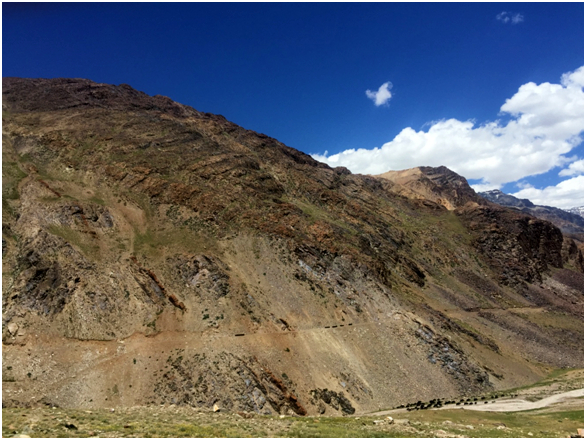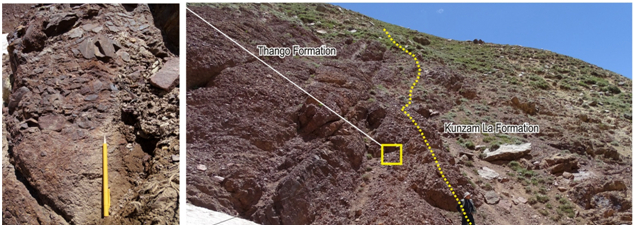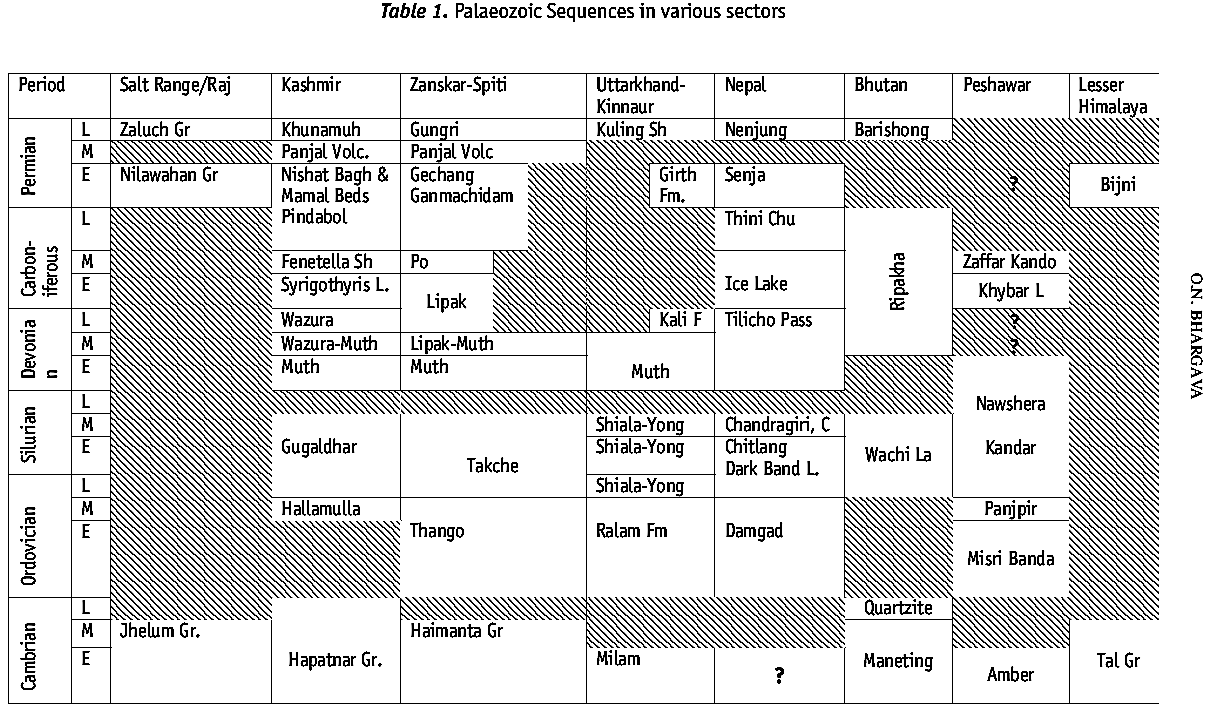Kunzam La Fm
Type Locality and Naming
Type section is in Kunzam Pass, in Lahaul-Spiti region.
[Original Publication: Srikantia, S. V., Ganesan, T. M., Sinha, P. K. and Tirkey, B. 1976. Geology of Part of Zanskar Mountains, Ladakh Himalaya with special reference to late Caledonian “Kurgiakh Orogeny”. “Geology, Mineral Resources and Natural Resources of Power Development of Himalayas with particular Reference to Kashmir”. Geological Survey of India, Abstracts, 1–3. Srikantia, S.V., 1981. The lithostratigraphy, sedimentation and structure of Proterozoic–Phanerozoic formations of Spiti basin in the higher Himalaya of Himachal Pradesh, India. In: Sinha, A.K. (Ed.), Contemporary Geoscientific Researches in India (a commemorative volume in honor of S.P. Nautiyal). Bishen Singh Mahendra Pal Singh, Dehra Dun, pp. 31–48; Nanda, M.M. and Singh, M.P. (1977) Stratigraphy and sedimentation of the Zanskar area, Ladakh and adjoining parts of the Lahaul region of Himachal Pradesh. Him. Geol., v.6, pp.365-388] [Singh, G., Mehra, S., Gupta, S., and Arora, R. K. 1991.Compilation of Stratigraphic Lexicon on Palaeozoic and Mesozoic sequences of Higher Himalayan Belt of NW Himalaya. Records of Geological Survey of India, 124: 257-259.] [Myrow, P. M., Snell, K. E., Hughes, N. C., Paulsen, T. S., Heim, N., and Parcha, S. K. 2006. Cambrian Stratigraphy and depositional history of the northern Indian Himalaya, Spiti Valley, north- central India.Geological Society of America Bulletin, 118: 491-510.]
Synonyms: Parahio Formation (Singh et al., 1991; Myrow et al., 2006)
[Figure: Zanskar-Spiti-Kumaun region location (provided by Om Bhargava)]
Lithology and Thickness
Sandstone. Comprised of sandstone, shale, siltstone with lenticular bends of brown-weathering limestone, dolomite and pink and brown quartzite. Along type section >3300 m thick. Bhargava et al (1991) description: Formation is 2200-3290 m thick. White purplish sandy-calcareous in upper part. Sandy-claystone in middle and light green. Poorly sorted quartz-sandstone in middle parts, fine to medium grained, moderately sorted, subrounded to subangular quartz in clayey matrix. Claystone, grey green in basal. Quartz-sandstone in basal, fine to medium grained, moderately sorted, subrounded to subangular quartz in clayey matrix.
[Figure 1: Out crop photographs of the Kunzam La Formation on the road from the Kunzam La Pass to Losar village, Spiti region.]
[Figure 2: Field photograph showing the contact of Kunzam La Formation and Thango Fm at Shian section, Pin Valley.]
Relationships and Distribution
Lower contact
Gradational, locally faulted lower contact with the underlying Batal Fm.
Upper contact
Upper contact with the Thango Fm is marked by a major angular unconformity.
GeoJSON
Fossils
Trace fossils are Diplichnites, Dimorphichnus, Phycodes, Gyrochorte; Grodia; Planolites; Skolithos, Scolica; Astroplithos; Rusophycus, Plagiogmous;
Acritarch: Anguloplanina
Brachiopods: Schizopholis napuru, Aksarinaia sp., Paterina sp., Eohadrotreta haydeni, Oepikites? haimantensis, Acrothele vertex, Linnarsonnia parahioensis, Aphelotreta khemangarensis, Acrothele? Praetans, Paterina? suspiciosa, Hadrotreta timchristiorum, Amictocracens? brocki (Popov et al., 2015)
Trilobites: Redlichia noetlingi; Pagetia significans, Oryctocephalus indicus, Opsidiscus haimantensis; Kunmingaspis stracheyi; K. pervulgata, K. stracheyi, Sahantungaspis himalica, Paramecephalus defossus, Ptychoparia consocialis; P. admissa; P. spitiensis; Hundwarella; Ironelessia etc. (Jell & Hughes, 1997, Peng et al., 2009). Peng et al., (2009) and Singh et al., (2016, 2017, 2020) demarcated the following trilobite biozones and levels from base to top in Cambrian of Parahio valley i.e., H. parvatya level; O. indicus biozone; K. parchina biozone, P. defossus biozone; O. salteri biozone; I. butes Zone. The characteristic trilobite fauna of each zone are summarized below from base to top are:
H. parvatya level: Haydenaspis parvatya; Prozacanthoides lahri; Mufushania nankingensis; Kaotaia sp. cf. gedongensis; Prowbowmania bhatti and Inoyia sp. indet.
O. indicus biozone: Ptychoparioid indet; Kunmingaspis pervulgata; Pagetia significans, and Oryctocephalus indicus
K. prachina biozone: Xingrenaspis parthiva; Bhargavia prakritika and Kaotaia prachina
Gunnia sp., Mufushania civica, Kunmingaspis stracheyi, Monanocephalus urceolatus, Paramechephalus defossus, Douposiella himalaica
P. defossus biozone: Changqingia sp., Kunmingaspis stracheyi, Gunnia sp., Ziboaspis hostilis, Solenoparia talingensis, Solenopoaria sp. cf. S. shanxiensis, Altiocculus sp. cf. A. striatus, Xingerenaspis shyamalae, Poriagraulos sp.,
O. salteri biozone: Kunmingaspis stracheyi, Ziboaspis hostilis, Oryctocephalus salteri, Opsidiscus haimantensis, Monanocephalus maopoensis, Hundwarella memor, Xingerenaspis hoboi
I. butes level: Iranoleesia butes, Xingerenaspis dardarpurensis
Age
Depositional setting
Additional Information



